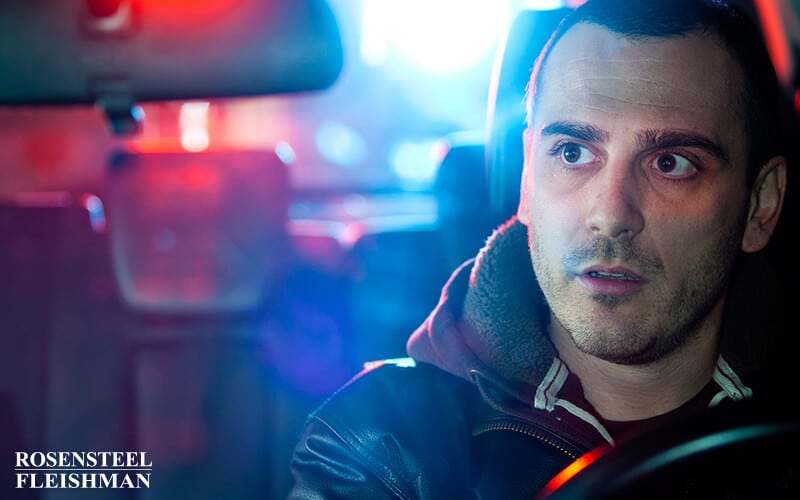While drunk driving accidents have been on the decline in the past few years, drunk driving is still a major problem in the United States and a leading cause of car accidents. The most recent statistics released by the National Highway Traffic Safety Administration show that approximately 28 people die in car accidents every day […]

Reliable Anonymous Tip Provides Reasonable Suspicion for Traffic Stop
What happens if you are driving home, reach down to change the radio station, and swerve so that you almost run another car off the road? Well, under a US Supreme Court case decided yesterday, a witness could make a 911 report of the incident which would provide reasonable suspicion for an officer to stop your vehicle for drunk driving.
In the case of Navarette v. California, a 911 caller reported that a truck ran her off the road. The highway patrol spotted the defendant’s truck, which matched the description in the report, shortly after the call was made and proceeded to follow the truck for 5 minutes. During this time, the officer did not observe any signs of criminal activity. The officer then stopped the defendant’s truck and smelled marijuana. Upon searching the vehicle, they found 30 pounds of marijuana. The defendant tried to suppress the evidence from the search by arguing that the traffic stop violated the Fourth Amendment because the officer did not have reasonable suspicion of criminal activity. Although the Court said that this case was a “close call,” it held that the anonymous tip provided reasonable suspicion for the officer to make a traffic stop.
Under the Fourth Amendment, an officer making a traffic stop must have “a particularized and objective basis for suspecting the particular person stopped of criminal activity.” The reasonable suspicion required to justify a traffic stop “is dependent upon both the content of information possessed by police and its degree of reliability.” To determine reasonable suspicion, you must look at the “totality of the circumstances.”
The Court begins its analysis in Navarette by recognizing that 911 calls are not per se reliable enough to justify a traffic stop because “an anonymous tip alone seldom demonstrates the informant’s basis of knowledge or veracity.” The call in Navaratte was reliable because the caller gave a specific description of the vehicle and the license plate number and gave details about the location of and the direction in which the vehicle was traveling. The location and description of the truck were corroborated by the officer who made the traffic stop. The call was also made soon after the caller was run off the road. In addition, the Court gave weight to the fact that the call was made through the 911 system which provided means of identifying the caller, even though the call was treated as anonymous.
After determining that the information provided in 911 call was reliable, the Court proceeded with the next step in its analysis stating that “a reliable tip will justify an investigative stop only if it creates reasonable suspicion that “criminal activity may be afoot.”” For criminal activity to be afoot, the defendant must be engaged in an ongoing crime such as drunk driving, rather than “an isolated episode of past recklessness.”
The Court cited a few cases which looked at reasonable suspicion for drunk driving and found that there were several indicators: “weaving all over the roadway”; “cross[ing] over the center line on a highway and almost caus[ing] several head-on collisions”; “driving all over the road and weaving back and forth”; and “driving in the median.” In contrast unconfirmed reports of minor traffic violations did not create reasonable suspicion for drunk driving.
Unconfirmed reports of driving without a seatbelt or slightly over the speed limit, for example, are so tenuously connected to drunk driving that a stop on those grounds alone would be constitutionally suspect. But a reliable tip alleging the dangerous behaviors discussed above generally would justify a traffic stop on suspicion of drunk driving.
Because the tipster in Navarette “alleged a specific and dangerous result of the driver’s conduct: running another car off the highway” which suggested “lanepositioning problems, decreased vigilance, impaired judgment, or some combination of those recognized drunk driving cues,” the Court determined that the reported “conduct bears too great a resemblance to paradigmatic manifestations of drunk driving to be dismissed as an isolated example of recklessness.”
So let’s go back to our initial hypothetical of driving home and leaning down to change the radio station, which makes you swerve and run another car off the road. There are clearly other possible explanations for the behavior observed by the tipster in Navarette. However, the Court states that reasonable suspicion “need not rule out the possibility of innocent conduct.” So it doesn’t matter if the defendant had swerved because he was changing the radio station, as long as the swerving could make an officer reasonably suspect he was drunk driving.
The Court states that a 911 call reporting a “minor traffic infraction” or a “conclusory allegation of drunk or reckless driving” would not provide reasonable suspicion to justify a traffic stop. The 911 call would have to contain some specific recognized indicator of drunk driving to provide reasonable suspicion.
In addition, the officer’s reasonable suspicion was not affected by the fact that the officer did not observe any erratic driving while following the defendant for 5 minutes before stopping him. The officer did not need to personally observe any erratic driving because the reasonable suspicion was already provided by the 911 call.
Now, let’s try a different hypothetical. What about a witness who observes a man stumble out of a bar and get into his car? The witness then calls 911 and reports the observation along with details about the car and the direction it is traveling. Would this be reasonable suspicion to justify a traffic stop if the officer spots the car and doesn’t observe any signs of erratic driving? It seems that the rationale from Navarette would support an officer’s stop in this case, since stumbling would be a specific indicator of impairment.
But what if instead the witness reported that he saw a “drunk man” get into his car and drive away? This call would be a “conclusory allegation” of drunk driving and would not provide reasonable suspicion under Navarette.
After the ruling in Navarette, it just got a little easier for law enforcement to make traffic stops. If you have been stopped and charged with a DWI, call an attorney at Rosensteel Fleishman Car Accident & Injury Lawyers right away (704) 714-1450.
Additional DWI Articles
I. You Will Need a Lawyer Just because someone has had drinks, does notautomatically mean that the law should rest on their shoulders and result in an automatic conviction. That is partly why, under North Carolina law, a series of safeguards have been adopted. These safeguards often rely on, and are helpfully followed, by experienced […]
I. Working While Impaired It is a sobering crisis. We cannot say for sure just exactly how many people drink during work hours, and then drive a vehicle within a short period of time after leaving the restaurant or bar. Often, it requires help from a car accident attorney to see if this drinking is […]
I. PC for DWI An experienced Charlotte criminal trial attorney is aware of the unique place that DWI charges can play in North Carolina courts. There’s no doubt that the public generally supports crackdowns on DWI offenses in North Carolina. But here’s the news flash: as important as DWI is, to maintaining public safety, it’s […]
